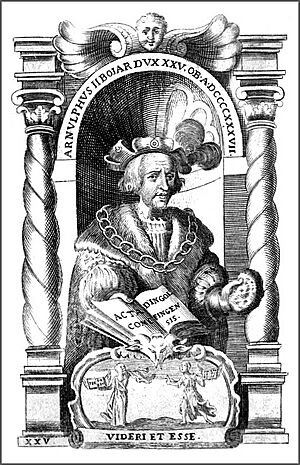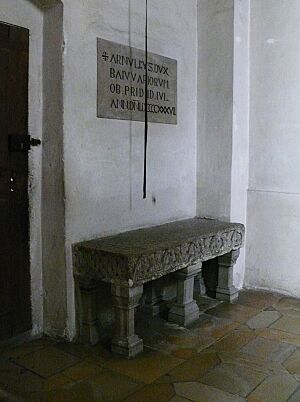Arnulf, Duke of Bavaria facts for kids
Quick facts for kids
Arnulf II
|
|
|---|---|
| Duke of Bavaria | |
 |
|
| Reign | 907–937 |
| Died | 14 July 937 Regensburg, Bavaria |
| Buried | St. Emmeram's Abbey |
| Noble family | Luitpoldings |
| Spouse(s) | Judith |
| Issue | Eberhard, Duke of Bavaria Judith, Duchess of Bavaria |
| Father | Luitpold, Margrave of Bavaria |
| Mother | Cunigunde of Swabia |
Arnulf II (died July 14, 937) was a powerful duke who ruled Bavaria from about 907 until his death. He was part of the Luitpolding family. People sometimes called him "the Bad" (in German, der Schlimme) because of some tough decisions he made during his rule. He is known for bringing Bavaria back together as a strong duchy.
Contents
Arnulf II: The Duke of Bavaria
The exact year Arnulf was born is not known. He was named after other important Arnulfs, like a bishop from the 600s and a king named Arnulf of Carinthia. Arnulf II was the son of Luitpold, who was a margrave (a type of ruler) in Bavaria. His mother was Cunigunde, who came from another important family.
Arnulf's father, Luitpold, had already become very strong in Bavaria. This was during a time when the East Frankish king, Louis the Child, was not very powerful. Luitpold controlled large areas along the Danube River, including the city of Regensburg.
Becoming Duke
In 907, a big battle happened near Pressburg (today's Bratislava). Arnulf's father, Luitpold, and many other Bavarian nobles were killed. They were fighting against the Hungarian forces. After his father's death, Arnulf took over his lands in Bavaria. Soon after, he took the title of "Duke of Bavaria." This meant he was the main ruler of the region around Regensburg.
Arnulf was a strong and determined leader. He had a lot of support from the local nobles. However, he immediately faced a big problem: constant attacks from the Hungarians. These attacks were causing a lot of damage across Bavaria and other parts of the East Frankish kingdom.
Why He Was Called "the Bad"
To fight off the Hungarians, Arnulf needed money. He decided to take land from churches and monasteries. He used these lands and their wealth to pay for a new army and improve defenses. This act of taking church property was very unusual for the time. Because of this, medieval writers gave him the nickname "the Bad."
Arnulf managed to push back the Hungarian invaders in several small battles. He even defeated a small Hungarian force in 913. He successfully brought Bavaria back together as a strong "stem duchy" (a large, independent region within a kingdom). Eventually, he made a peace agreement with the Hungarian leaders. After that, the Hungarians mostly passed through Bavaria when they raided other German lands.
Dealing with Kings
Duke Arnulf wanted Bavaria to be as independent as possible from the East Frankish kings. In 911, he helped elect Conrad I of Germany as king. But later, Arnulf supported his uncle against King Conrad. He also challenged King Henry the Fowler, who became king after Conrad.
In 916, King Conrad's forces attacked Bavaria and raided Regensburg. This forced Arnulf to flee and seek safety with his former enemies, the Hungarians. King Conrad was very angry. He even ordered the execution of Arnulf's uncle and brother.
In 919, King Conrad I died without children. This opened up the chance for Arnulf to return to Bavaria. He quickly came back and drove out the king's forces. Some historical records suggest that the Bavarians welcomed Arnulf and even wanted him to be king of the Germans. However, it's not fully clear if he was truly elected as an "anti-king" against Henry the Fowler.
King Henry I proved to be a strong ruler. He defeated Arnulf in two military campaigns in 921. When Henry surrounded Arnulf in Regensburg, Arnulf agreed to make peace. He recognized Henry as the German king. In return, King Henry allowed Arnulf to rule Bavaria with a lot of freedom. This included the right to appoint bishops and control important royal rights, as long as Arnulf gave up his claim to be king.
Later Years and Death
Arnulf joined King Henry I in a campaign against Wenceslaus of Bohemia in 928. In 935, he tried to get the Iron Crown of Lombardy (a famous crown used for kings of Italy) for his oldest son, Eberhard. But this attempt failed.
After King Henry died in 936, Arnulf attended the coronation of Henry's son, Otto, who became King of the Romans. This coronation took place at Aachen Cathedral.
Duke Arnulf died in Regensburg on July 14, 937. His son Eberhard took over as duke, but King Otto removed him from power in 938. Arnulf is buried at St. Emmeram's Abbey. A special plaque honoring him was placed at the Walhalla memorial in 1842.
Family Life
Historians believe Arnulf was married to a woman named Judith of Sülichgau. She was born around 888.
Arnulf and Judith had several children:
- Eberhard (born around 912, died around 940), who was Duke of Bavaria for a short time.
- Arnulf II (born around 912, died 954), who became a count palatine in Bavaria.
- Herman (died 954)
- Henry
- Louis (born around 930, died after 974)
- Judith (died after 984), who married Henry I of Bavaria, the brother of King Otto I.
- Berthold I, a margrave of Nordgau.
- Adelheid, who married Burkhard, a margrave.
See also
 In Spanish: Arnulfo de Baviera para niños
In Spanish: Arnulfo de Baviera para niños


